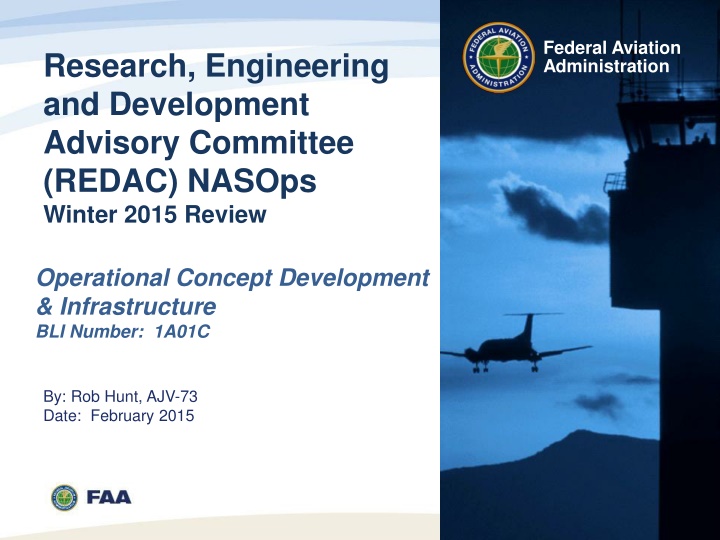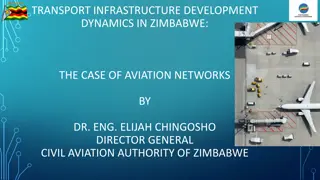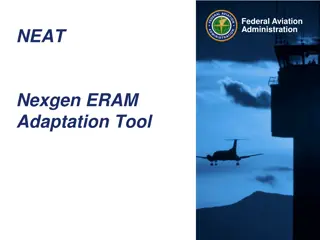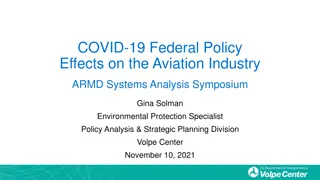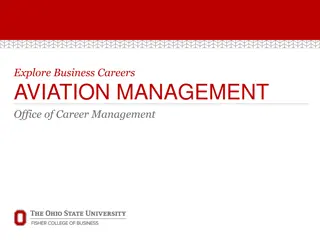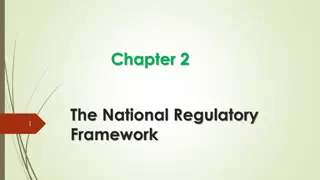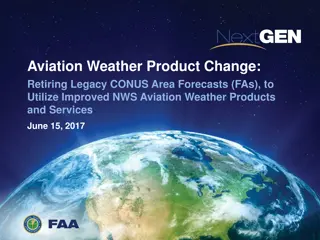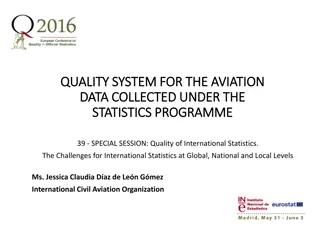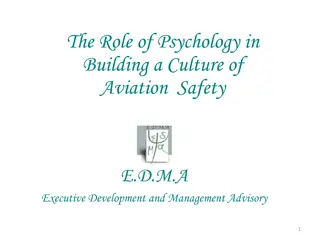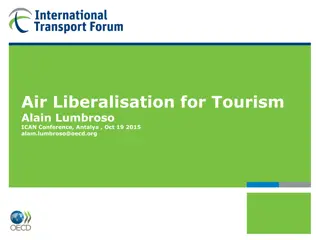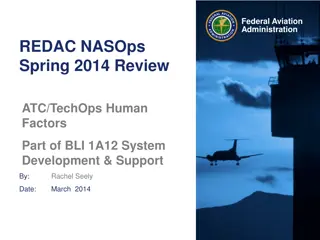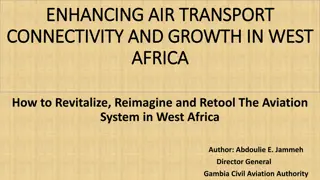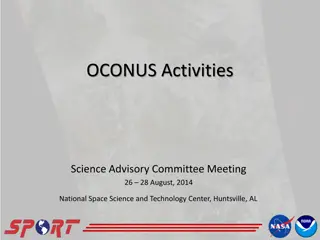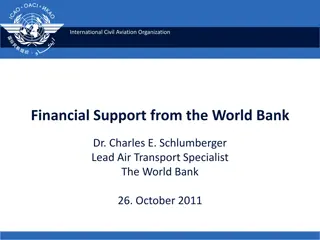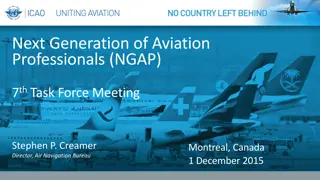Federal Aviation Administration Research, Engineering and Development Advisory Committee Review
The Federal Aviation Administration's Research, Engineering and Development Advisory Committee's operational concept development and infrastructure review for Winter 2015. The organizational chart of the Mission Support Services provides insights into the leadership structure and divisions within the committee.
Download Presentation

Please find below an Image/Link to download the presentation.
The content on the website is provided AS IS for your information and personal use only. It may not be sold, licensed, or shared on other websites without obtaining consent from the author.If you encounter any issues during the download, it is possible that the publisher has removed the file from their server.
You are allowed to download the files provided on this website for personal or commercial use, subject to the condition that they are used lawfully. All files are the property of their respective owners.
The content on the website is provided AS IS for your information and personal use only. It may not be sold, licensed, or shared on other websites without obtaining consent from the author.
E N D
Presentation Transcript
Federal Aviation Administration Research, Engineering and Development Advisory Committee (REDAC) NASOps Winter 2015 Review Operational Concept Development & Infrastructure BLI Number: 1A01C By: Rob Hunt, AJV-73 Date: February 2015
Mission Support Services (AJV) Organizational Chart Vice President AJV-0 Elizabeth Lynn Ray Executive Assistant AJV-0 Valentina Smith Senior Advisor AJV-0 Rodger Dean (A) Deputy Vice President AJV-0 Bill Davis Special Projects AJV-0 Wayne Eckenrode Aeronautical Information Management AJV-2 Director Joshua Gustin Airspace Services AJV-1 Director Dennis Roberts Air Traffic Procedures AJV-8 Director TBD ATO Operational Concepts, Validation & Requirements AJV-7 Director Greg Burke Western Service Center AJV-W Director Edie Parish (A) Central Service Center AJV-C Director Gus Nezer Eastern Service Center AJV-E Director Mark Ward AeroNav Products AJV-3 Director Abby Smith (A) Deputy Director AJV-1 Frank Black Senior Advisor AJV-W Kimberly Flanigan En Route Products Group AJV-31 George Davis Process & Publications Group AJV-81 Senior Advisor AJV-E (A) Debra Fay Senior Advisor AJV-C Sharon Rushing National Flight Data Center Group AJV-21 Dick Powell Deputy Director AJV-7 Vacant Senior Advisor AJV-1 Leslie Swann Quality Control Group, AJV-W1 Chuck Chamberlain Visual Charting & Airport Mapping Group AJV-32 Eric Freed Quality Control Group, AJV-E1 (A) John Myles Quality Control Group, AJV-C1 Tony Roetzel Geographic Services Group AJV- 22 Dick Powell Air Traffic Control Procedures Group AJV-82 Airspace Regulations Group AJV-11 (Acting) Gary Norek Process Control Services Group AJV-71 Pamela Curry Operations Support Group, AJV-W2 Clark Desing Operations Support Group, AJV-E2 Kip Johns Data System Architecture Group AJV-23 Dan Gerecht Operations Support Group, AJV-C2 David Medina Product Support Group AJV-34 Karen Gonzalez Airspace Optimization Group AJV-12 (A) Howie Callon ATO Operational Concepts Group AJV-72 Sharon Kurywchak Planning and Requirements Group AJV-W3 James Valle Planning and Requirements Group, AJV-E3 Ryan Almasy Planning and Requirements Group, AJV-C3 Denise Knight Terminal Products Group AJV-35 Gregory Yamamoto PBN Policy & Support Group AJV-14 (A) Sharon Abhalter AIM Operations Group AJV-24 (Acting) Glenn Sigley Technical Analysis & Operational Requirements Group AJV-73 Rob Hunt Business Services Group, AJV-W4 Jay Egbert Production Technology & Air Traffic Products Group AJV-36 Eric Secretan Business Services Group, AJV-E4 Larry Barts Obstruction Evaluation Group AJV-15 John Page Business Services Group, AJV-C4 Jeff Tague Engineering Support Group AJV-25 Jim Scott Administrative Services Group, AJV-W5 Julie Fidler Business Support Group AJV-17 Steve Holliday Administrative Services Group, AJV-E5 Maria James Administrative Services Group, AJV-C5 Lyndon Dyer AIM Systems Group AJV-26 Glenn Sigley AeroNav Products Logistics Group AJV-37 Patricia Banks Terminal & En Route Oceanic Airspace Group AJV-18 Martin Adams 2
AJV-7 Organizational Relationships ATO Ops AJM Program Execution NextGen NextGen AJM-2 AJM-3 AJW AJR AJT AJI Organizational Relationships Expert Teams Evals, Alts, Trades, Opportunities S h o r t f a l l s N e e d s & Service Areas Mission Support AJV-7 Process Control (AJV-71) Concept Dev, Shortfall Analysis, Maturity Assessment Operational Concepts (AJV-72) Operational Requirements (AJV-73) 3
AJV-7 Organizational Framework Process design, facilitation, and continuous improvement utilizing quality metrics o Design, develop and execute quality assurance and control o Defining monitoring and performance metrics of defined processes Manage and maintain (operations) PLA master database Provide business services (financial and contract management, etc) Process Control AJV-71 Cross-ATO coordination and engagement of service units to create: Operational shortfalls, concept exploration and scenario development o Prioritized needs for future development & releases o Singular operational input (response) to documents describing the future environment, including NSIP, NGIP, NAS EA, etc. o Day to day operations in the NAS Recommend improvements and establish criteria and standards for implementation of Terminal and EnRoute systems Determine operational suitability Validate equipment Operational Concepts AJV-72 Technical analysis & validation of operational concepts and scenarios, including: o Generation of use cases derived from the concepts & scenarios o Generation of prioritized operational requirements Identification and conduct of analyses, modeling, and simulations In collaboration with AJV-72, conduct/document shortfall analyses, concept development, and concept validation Development of operational & functional requirements Manage projects through Service Analysis and CRD Lead the development/progress of investments up to IARD Milestone in AMS (materiel/non-materiel) and develop required documentation (e.g. CONUSE, pPR, projected costs/benefits, EA artifacts, etc) Conduct requirements continuity analysis and implementation planning support as investments progress through AMS Operational Requirements AJV-73 4
Operations Concept Development & Infrastructure - ATDP Program Description: Develop, mature, and validate near/mid-term emerging operational concepts to improve the capacity and efficiency of the NAS. Identify and mitigate operational integration concept challenges, focusing on optimizing the integration amongst emerging concepts, and amongst emerging concepts and existing NAS capabilities. Advance an enterprise-based perspective to the evolution of NAS capabilities, enabling a more integrated, synchronized, and sustainable NAS. Partnerships: ANG-C4/C5 PMO Volpe NASA Funding Overview: FY11 FY12 FY13 FY14 FY15 FY16 FY17 FY18 FY19 FY20 $4M $3.5M $3.953M $4M $4M $4M $4M $4M $6M $6M
Operations Concept Development & Infrastructure - ATDP Why is this program necessary? The FAA is proceeding with NAS modernization based on the NextGen Operational Concept for 2025. Concept development and validation is necessary to investigate specific concept elements, and to drive out operational and technical requirements and implications for human factors, training and procedures. This program assesses the interaction of changing roles and responsibilities of NAS service providers and pilots, airspace changes, procedural changes and new mechanized systems for distributing weather, traffic and other flight related information. It tests the assumptions behind common situational awareness and distributed information processing. The program uses analyses and associated white papers to validate whether future system requirements meet NextGen goals, including the flight data processing evolution in En Route Automation Modernization (ERAM), data communications, the future voice switch, changes in surveillance requirements and associated procedures, establishment of new roles and responsibilities to support increased productivity, etc. It will develop methods, metrics, and models to demonstrate that the modernized system can handle anticipated growth in traffic demand according to the Terminal Area Forecasts (TAF) for incremental years. This supports the goal of continued US leadership internationally and helps ensure the global harmonization through continued support for the ICAO Global ATM operational concept, the development of global requirements, and the definition of an air transportation performance framework.
Operations Concept Development & Infrastructure - ATDP What are the benefits to the FAA The activity supports the FAA s Strategic Initiatives by delivering benefits through technology and infrastructure; Concept validation supports development, analysis, and simulation of new concepts to assess requirements and to evaluate the impact of the concept on system capacity, efficiency, safety and human performance. Evaluation criteria include the following: Impact/Improvement to Air Traffic Service Providers, airspace users, and automation that could increase capacity, Impact/Improvement on airspace structure which may increase productivity and hence capacity, Impact/Improvement on communication, navigation, and surveillance (CNS) requirements to support the FAA's efforts to reducing cost, increasing capacity and efficiency and; Impact/Improvement on automation, display, and facility configuration elements to increase productivity and hence capacity. What determines program success Success is measured by the completion of the goals identified in multi-year plans developed for each activity. Initiatives that successfully complete all the project goals identified are then presented as candidates for acquisition. 7
Operations Concept Development & Infrastructure - Accomplishments Unmanned Aircraft Systems (UAS) Concept Maturation: Developed UAS Stakeholder Concept Validation External Stakeholder Engagement Plan UAS Concept Maturation & Validation accomplishments: Performed initial assessment of gaps and concept elements in need of maturation associated with the UAS ConOps Version 2.0 document Modified existing scenarios and created new scenarios deemed necessary through tabletop discussions with working group ATC and UAS SMEs Updated initial concept level operational requirements based on scenario development/modifications and tabletop discussions with working group SMEs Vetted scenarios with ATC SMEs Updated concept level operational requirements based on scenario vetting sessions with ATC SMEs and other key stakeholders Mid-term Timeframe 2018-2020 Conducted analysis to establish framework and assumptions for mid-term environment Projected NAS capabilities and traffic projections Identified mature state concept elements that may be applicable in the mid-term Developed operational scenarios that investigated specific mid-term impacts on ATC/ATM operations Derived initial set of operational requirements from scenario development and tabletop discussions with ATC and UAS SMEs Vetted scenarios with ATC SMEs (other than working group SMEs) & other key stakeholders Updated operational requirements based on scenario vetting sessions with ATC SMEs & other key stakeholders
Operations Concept Development & Infrastructure - Accomplishments Operational Integration Analysis: Developed operational representation of operational changes to reduce potential risk when implementing mid-term enhancements / capabilities / initiatives Performed and documented operational integration analysis/vetting using scenarios for several phases of flight and the NSIP Alpha and Bravo segments. Was conducted with SMEs for En Route, TRACON, Oceanic and En Route Cruise Flight Operations. Analysis Illustrated mid-term capability interactions Identified key integration and interoperability risk areas (holes, gaps, opportunities) Developed potential mitigations for the identified potential risk Utilized this program methodology to establish a baseline for assessing future changes National Special Activity Airspace (NSAAP): Developed NSAAP Strategic Plan and Multi-Year Project Plan once leadership of NSAAP was transitioned to AJV-7 (2013). Conducted analysis of project artifacts at time of leadership change Initiated shortfall analyses and ConUse development, and maturation activities Identified requirements gaps between NSAAP and other ongoing activities Developed As is case and identified the shortfalls for ERAM-SAA Integration for ERAM Sector Enhancement Developed SAA-ATM Integration Shortfalls Provided SAMS-ERAM integration options/recommendations for ERAM Sector Enhancement Continued shortfall analysis and operational scenario development activities for other operational domains Identified new requirements for SAMS Briefed the National Customer Forum on current and planned activities .
Operations Concept Development & Infrastructure - Accomplishments Enterprise IDS (E-IDS): Identified AT information integration shortfalls and recommended mitigations Conducted Stakeholder meetings to review overall investment and future activities Developed budget and schedule estimates to prepare for a CRD RD for the emerging investment later this year Finalized program Shortfalls Assessment Documentation Achieved CRD RD in 2014 RTCA: This program contributes to the FAA's support for the RTCA, a non-profit association that develops standards based on manufacturers, government, and aviation operator inputs. RTCA also recommends operational improvements to increase the efficiency of air transportation. Continued support and analysis of International standard and public/private collaboration
Operations Concept Development & Infrastructure FY17 Operational Integration Analysis Objective: Continued examination of possible operational integration issues as emerging concepts evolve and new concepts are planned for the mid-term Potential Activities: Scenario development/update/execution, mitigation recommendations (e.g. further research, requirements) PBN Optimization Objective: Expand the efficient use of PBN procedures in the NAS Potential Activities: Service analyses activities to identify obstacles and mitigations for proliferation of PBN Interval Management Objective: Mature advanced interval management applications Potential Activities: Concept validation through scenario development/execution, HITLs exercises, Part Tasks Trajectory-Based Operations Objective: Mature Trajectory-Based Operations (TBO) concept Potential Activities: Leveraging previous trajectory-related pieces (PBN, IM, DataComm, system trajectory improvements, RTCA work), mature and evaluate the TBO conops RTCA Support Continued support of international standards and public/private collaboration 11 11
Questions? 12
Operations Concept Development & Infrastructure FY15 Focus Unmanned Aircraft Systems (UAS) Concept Maturation Objective: Enable the future increased use of UASs in the NAS Activities: Scenario development/execution, functional analysis, requirements development Operational Integration Analysis Objective: Identify possible operational integration issues amongst emerging concepts, and amongst emerging concepts and existing operational capabilities Activities: Scenario development/execution, mitigation recommendations (e.g. further research, requirements) Enterprise-Based Information Delivery and Dissemination Objective: Create an enterprise-based perspective and delivery/dissemination platform for AT support information (existing information and new information planned to be available in the mid-term) Activities: Shortfall analyses, conceptual solutions, requirements development National Special Activity Airspace (SAA) Concept Maturation Objective: Improve the scheduling and real-time use of SAA in the NAS Activities: Concept validation, CONOPs revision, requirements development, requirements allocation Interval Management Concept Exploration Objective: Evaluate Interval management applications Activities: Concept development, high-level CONOPs RTCA Support Continued support of international standards and public/private collaboration 14 14
Description: Develop, mature, and validate near/mid-term emerging operational concepts to improve the capacity and efficiency of the NAS Identify and mitigate operational integration concept challenges, focusing on optimizing the integration amongst emerging concepts, and amongst emerging concepts and existing NAS capabilities Advance an enterprise-based perspective to the evolution of NAS capabilities, enabling a more integrated, synchronized, and sustainable NAS ATDP - Operations Concept Validation and Infrastructure Evolution Partnerships: ANG/C4/C5 PMO Volpe NASA Accomplishments / Plans: Identify and mitigate operational integration issues through the development and execution of operational scenarios with SMEs (May 14) Update existing, create new, and execute operational scenarios with SMEs to evaluate the use of UASs in the NAS (May 14) Shortfall analyses of AT spt info (Sep 14) Develop SAA-ATM integration requirements and identify enabling policies/procedures to improve the use of SAAs in the NAS (Sep 14) RTCA: Analyses/documentation in support of standards and public/private collaboration Funding: FY11 FY12 FY13 FY14 FY15 $4,000,000 $3,500,000 $3,953,000 $4,000,000 $4,000,000 (projected) AJV-7 controls funding from FY13 and beyond.
